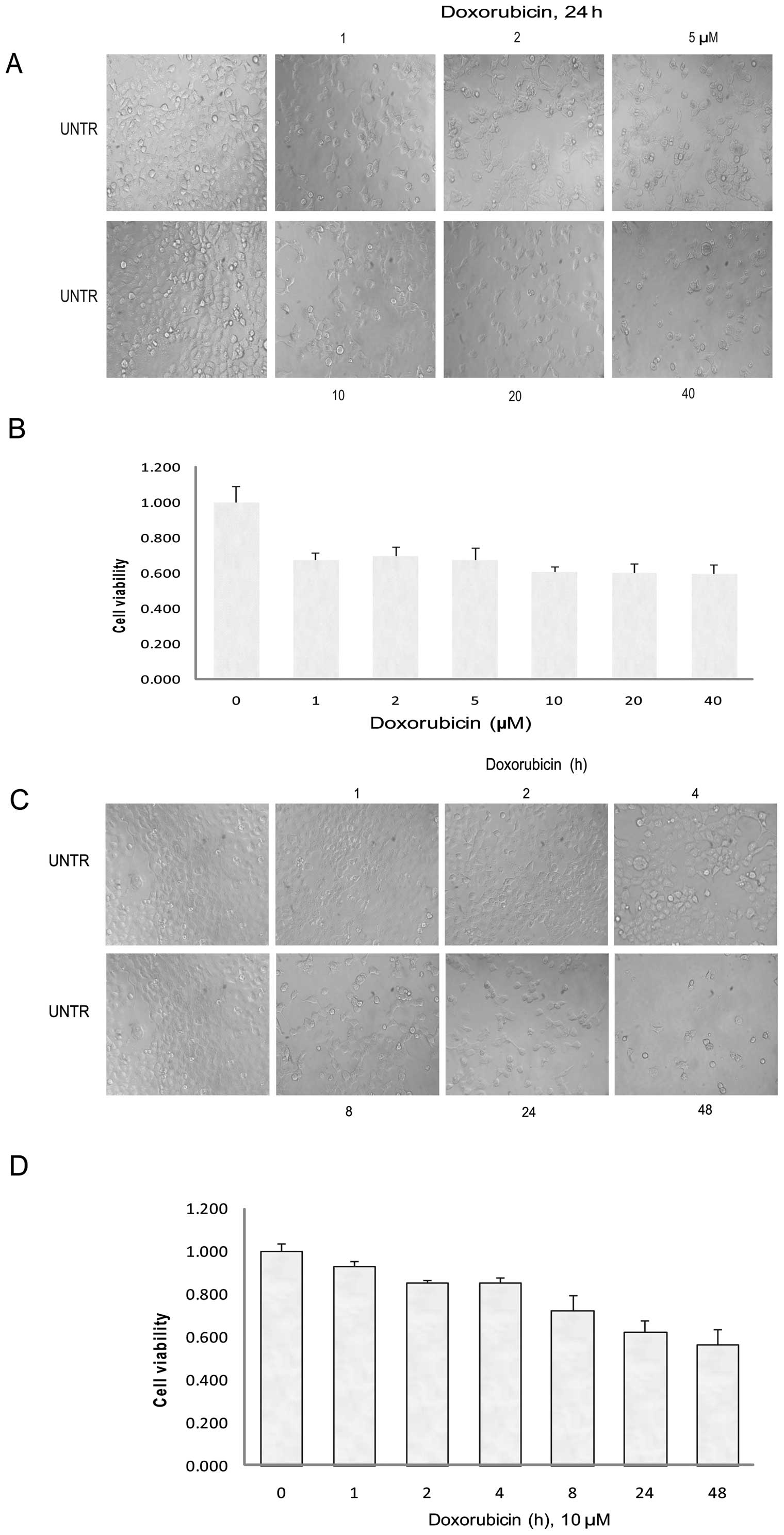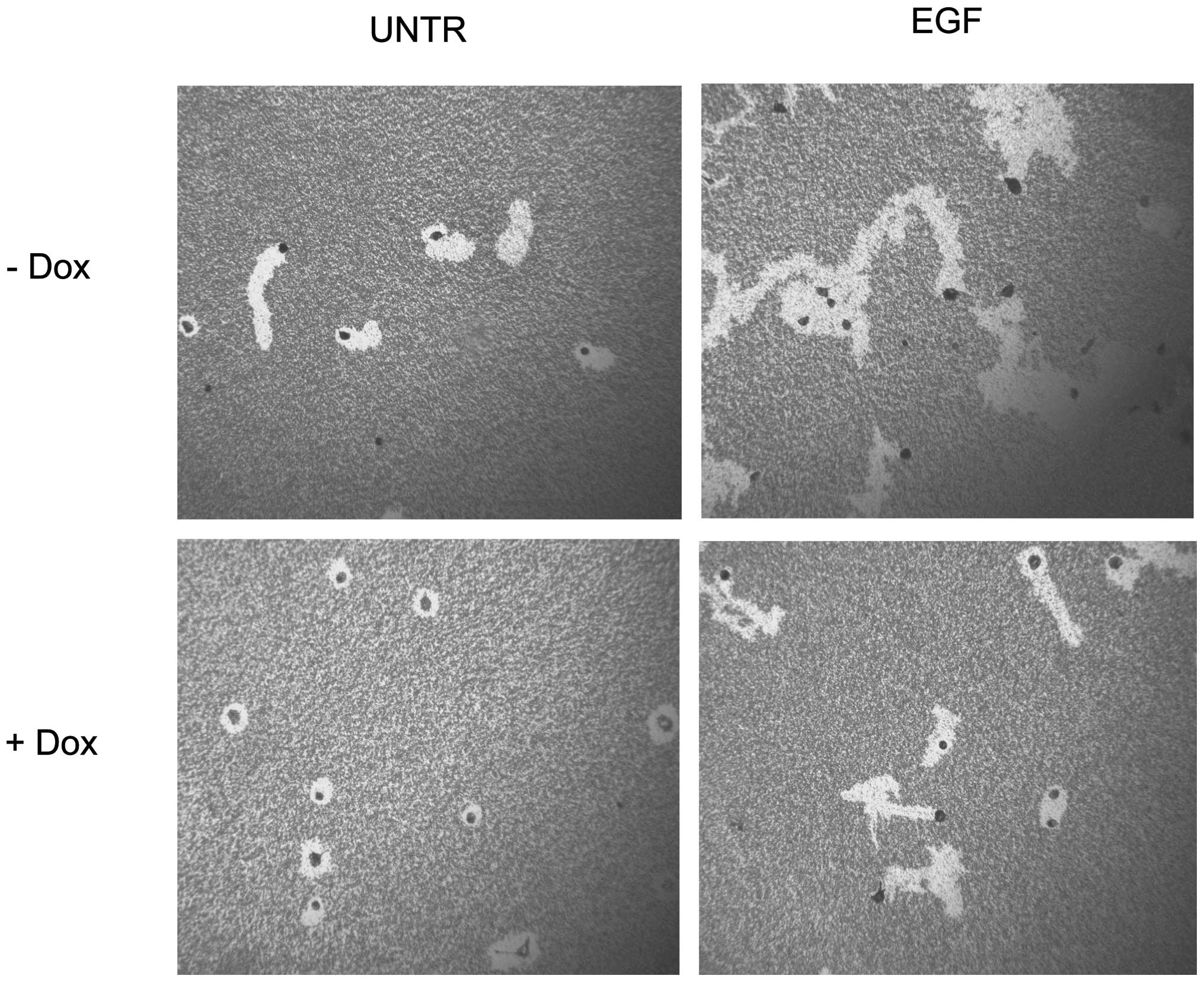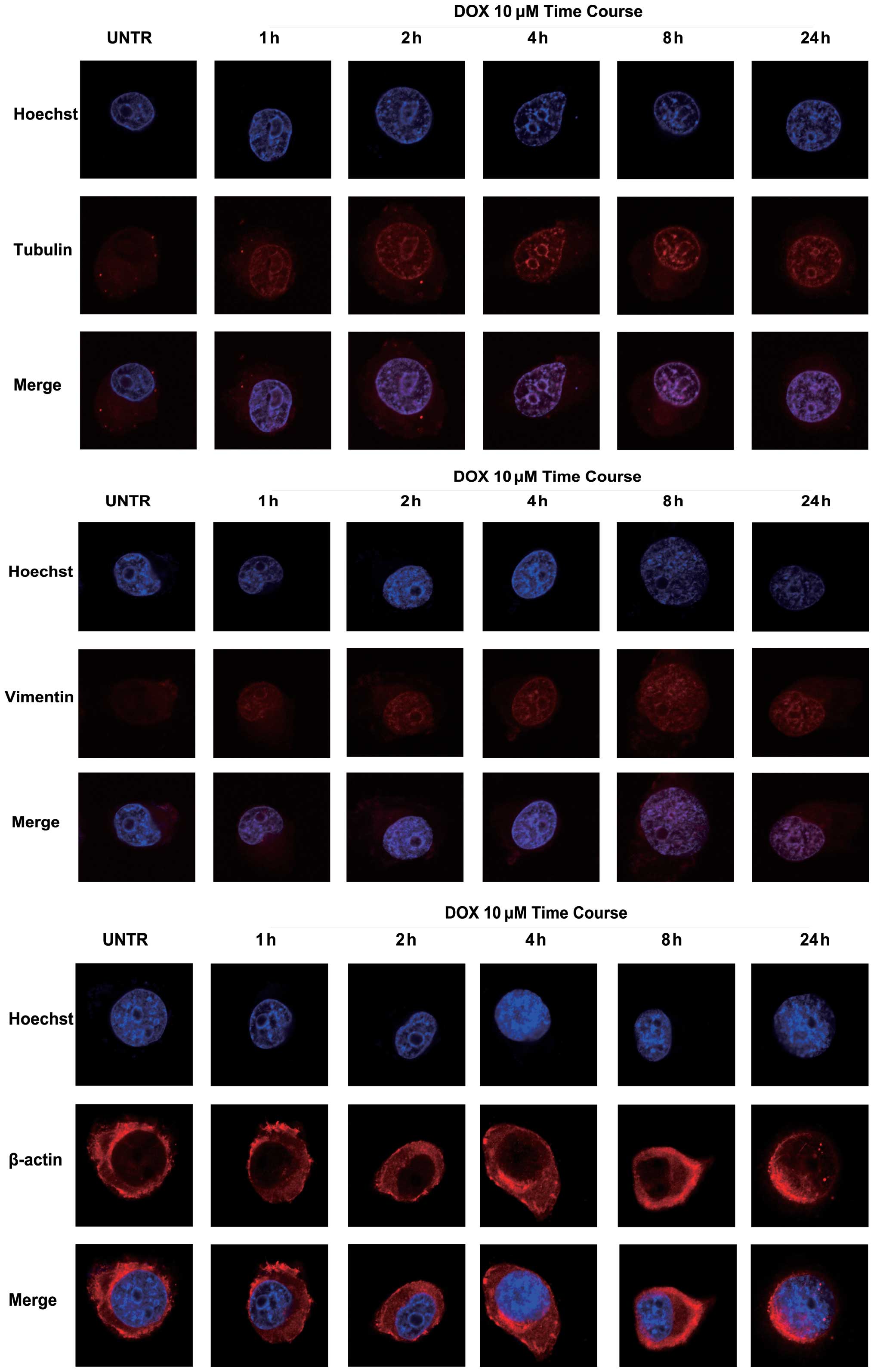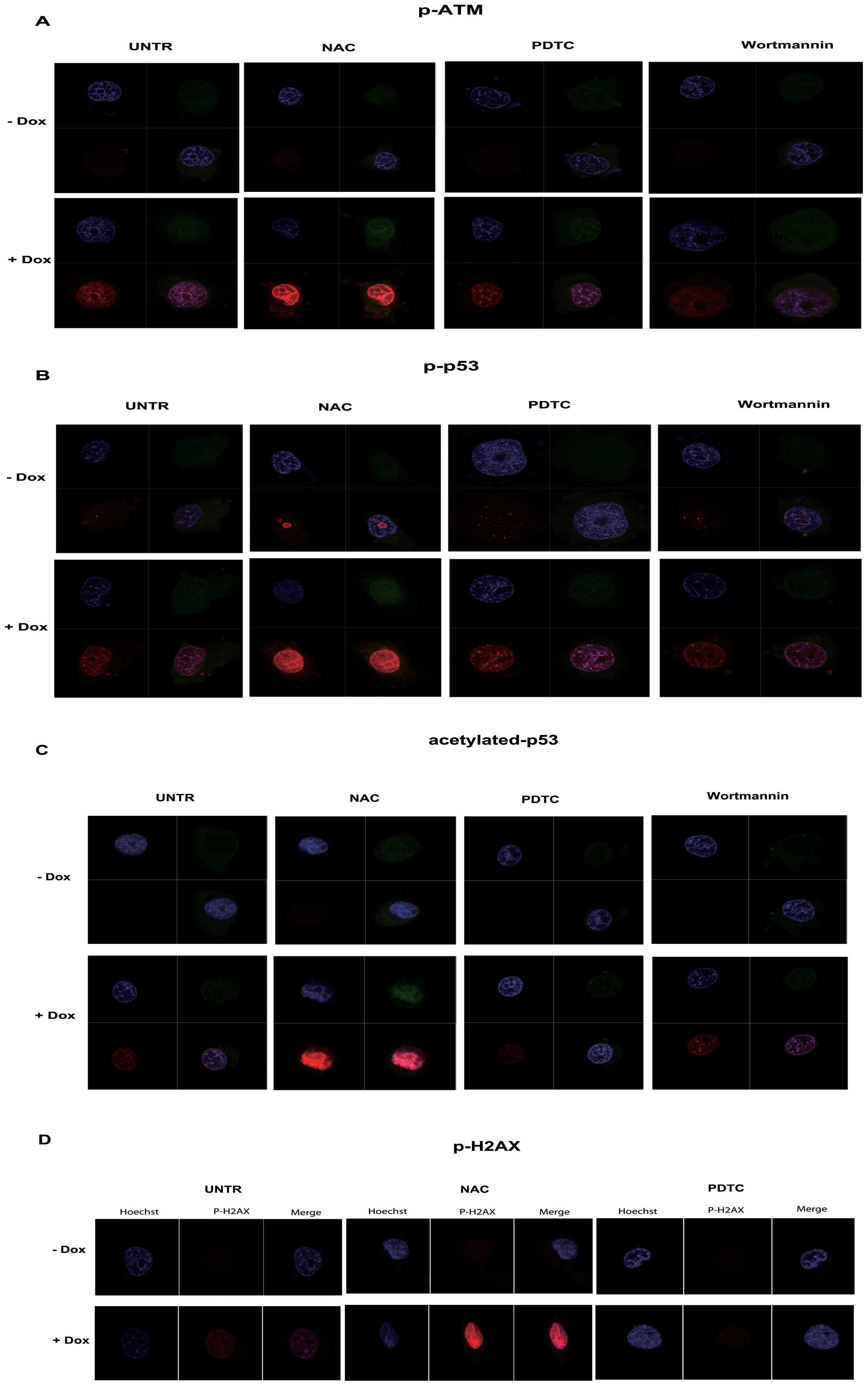|
1.
|
Sardao VA, Oliveira PJ, Holy J, Oliveira
CR and Wallace KB: Morphological alterations induced by doxorubicin
on H9c2 myoblasts: nuclear, mitochondrial, and cytoskeletal
targets. Cell Biol Toxicol. 25:227–243. 2009. View Article : Google Scholar : PubMed/NCBI
|
|
2.
|
Hublarova P, Greplova K, Holcakova J,
Vojtesek B and Hrstka R: Switching p53-dependent growth arrest to
apoptosis via the inhibition of DNA damage-activated kinases. Cell
Mol Biol Lett. 15:473–484. 2010. View Article : Google Scholar : PubMed/NCBI
|
|
3.
|
Eom YW, Kim MA, Park SS, Goo MJ, Kwon HJ,
Sohn S, Kim WH, Yoon G and Choi KS: Two distinct modes of cell
death induced by doxorubicin: apoptosis and cell death through
mitotic catastrophe accompanied by senescence-like phenotype.
Oncogene. 24:4765–4777. 2005. View Article : Google Scholar : PubMed/NCBI
|
|
4.
|
Kurz EU, Douglas P and Lees-Miller SP:
Doxorubicin activates ATM-dependent phosphorylation of multiple
downstream targets in part through the generation of reactive
oxygen species. J Biol Chem. 279:53272–53281. 2004. View Article : Google Scholar : PubMed/NCBI
|
|
5.
|
Voisard R, Seitzer U, Baur R, Dartsch PC,
Osterhues H, Hoher M and Hombach V: A prescreening system for
potential antiproliferative agents: implications for local
treatment strategies of postangioplasty restenosis. Int J Cardiol.
51:15–28. 1995. View Article : Google Scholar
|
|
6.
|
Otsuka Y, Tanaka T, Uchida D, Noguchi Y,
Saeki N, Saito Y and Tatsuno I: Roles of cyclin-dependent kinase 4
and p53 in neuronal cell death induced by doxorubicin on cerebellar
granule neurons in mouse. Neurosci Lett. 365:180–185. 2004.
View Article : Google Scholar : PubMed/NCBI
|
|
7.
|
Panta GR, Kaur S, Cavin LG, Cortes ML,
Mercurio F, Lothstein L, Sweatman TW, Israel M and Arsura M: ATM
and the catalytic subunit of DNA-dependent protein kinase activate
NF-kappaB through a common MEK/extracellular signal-regulated
kinase/p90(rsk) signaling pathway in response to distinct forms of
DNA damage. Mol Cell Biol. 24:1823–1835. 2004. View Article : Google Scholar
|
|
8.
|
Wu R, Hu TC, Rehemtulla A, Fearon ER and
Cho KR: Preclinical testing of PI3K/AKT/mTOR signaling inhibitors
in a mouse model of ovarian endometrioid adenocarcinoma. Clin
Cancer Res. 17:7359–7372. 2011. View Article : Google Scholar : PubMed/NCBI
|
|
9.
|
Litwiniec A, Grzanka A, Helmin-Basa A,
Gackowska L and Grzanka D: Features of senescence and cell death
induced by doxorubicin in A549 cells: organization and level of
selected cytoskeletal proteins. J Cancer Res Clin Oncol.
136:717–736. 2010. View Article : Google Scholar : PubMed/NCBI
|
|
10.
|
Grzanka A, Grzanka D and Orlikowska M:
Cytoskeletal reorganization during process of apoptosis induced by
cytostatic drugs in K-562 and HL-60 leukemia cell lines. Biochem
Pharmacol. 66:1611–1617. 2003. View Article : Google Scholar : PubMed/NCBI
|
|
11.
|
Bijman MN, van Berkel MP, van Nieuw
Amerongen GP and Boven E: Interference with actin dynamics is
superior to disturbance of microtubule function in the inhibition
of human ovarian cancer cell motility. Biochem Pharmacol.
76:707–716. 2008. View Article : Google Scholar : PubMed/NCBI
|
|
12.
|
Qiu L, Zhou C, Sun Y, Di W, Scheffler E,
Healey S, Wanebo H, Kouttab N, Chu W and Wan Y: Paclitaxel and
ceramide synergistically induce cell death with transient
activation of EGFR and ERK pathway in pancreatic cancer cells.
Oncol Rep. 16:907–913. 2006.PubMed/NCBI
|
|
13.
|
Albrecht-Buehler G: The phagokinetic
tracks of 3T3 cells. Cell. 11:395–404. 1977. View Article : Google Scholar : PubMed/NCBI
|
|
14.
|
Qiu L, Wang Q, Di W, Jiang Q, Schefeller
E, Derby S, Wanebo H, Yan B and Wan Y: Transient activation of
EGFR/AKT cell survival pathway and expression of survivin
contribute to reduced sensitivity of human melanoma cells to
betulinic acid. Int J Oncol. 27:823–830. 2005.PubMed/NCBI
|
|
15.
|
Qiu L, Di W, Jiang Q, Scheffler E, Derby
S, Yang J, Kouttab N, Wanebo H, Yan B and Wan Y: Targeted
inhibition of transient activation of the EGFR-mediated cell
survival pathway enhances paclitaxel-induced ovarian cancer cell
death. Int J Oncol. 27:1441–1448. 2005.PubMed/NCBI
|
|
16.
|
Bagriacik EU, Uslu K, Yurtcu E, Stefek M
and Karasu C: Stobadine inhibits doxorubicin-induced apoptosis
through a caspase-9 dependent pathway in P815 mastocytoma cells.
Cell Biol Int. 31:979–984. 2007. View Article : Google Scholar : PubMed/NCBI
|
|
17.
|
Rogalska A, Gajek A, Szwed M, Jozwiak Z
and Marczak A: The role of reactive oxygen species in WP
631-induced death of human ovarian cancer cells: a comparison with
the effect of doxorubicin. Toxicol In Vitro. 25:1712–1720. 2011.
View Article : Google Scholar : PubMed/NCBI
|
|
18.
|
McLoon LK, Falkenberg JH, Dykstra D and
Iaizzo PA: Doxorubicin chemomyectomy as a treatment for cervical
dystonia: histological assessment after direct injection into the
sternocleidomastoid muscle. Muscle Nerve. 21:1457–1464. 1998.
View Article : Google Scholar
|
|
19.
|
Ji C, Cao C, Lu S, Kivlin R, Amaral A,
Kouttab N, Yang H, Chu W, Bi Z, Di W and Wan Y: Curcumin attenuates
EGF-induced AQP3 up-regulation and cell migration in human ovarian
cancer cells. Cancer Chemother Pharmacol. 62:857–865. 2008.
View Article : Google Scholar : PubMed/NCBI
|
|
20.
|
Necco A, Vailati G and Colombo R: Actin
behaviour in doxorubicin treatment. Cell Biol Int Rep. 7:129–134.
1983. View Article : Google Scholar : PubMed/NCBI
|
|
21.
|
Dalledonne I, Milzani A and Colombo R: DXR
depresses the alpha-actinin-induced formation of actin bundles.
Cancer Biochem Biophys. 13:245–254. 1993.PubMed/NCBI
|
|
22.
|
Necco A, Usardi C, Scari G, Islam K,
Melzner I and Vergani G: The effects of doxorubicin on embryonic
spinal motoneurons cultured in vitro: cytoskeletal response.
Cytotechnology. 11:133–141. 1993. View Article : Google Scholar : PubMed/NCBI
|
|
23.
|
Colombo R, Necco A, Vailati G, Saracco B,
Milzani A and Scari G: Doxorubicin affects actin assembly in vitro.
Cell Biol Int Rep. 8:127–135. 1984. View Article : Google Scholar : PubMed/NCBI
|
|
24.
|
Mariano R, Gonzalez B and Lewis W: Cardiac
actin interactions with doxorubicin in vitro. Exp Mol Pathol.
44:7–13. 1986. View Article : Google Scholar : PubMed/NCBI
|
|
25.
|
Jaamaa S, Af Hallstrom TM, Sankila A,
Rantanen V, Koistinen H, Stenman UH, Zhang Z, Yang Z, De Marzo AM,
Taari K, Ruutu M, Andersson LC and Laiho M: DNA damage recognition
via activated ATM and p53 pathway in nonproliferating human
prostate tissue. Cancer Res. 70:8630–8641. 2010. View Article : Google Scholar : PubMed/NCBI
|
|
26.
|
Alexandre J, Hu Y, Lu W, Pelicano H and
Huang P: Novel action of paclitaxel against cancer cells: bystander
effect mediated by reactive oxygen species. Cancer Res.
67:3512–3517. 2007. View Article : Google Scholar : PubMed/NCBI
|
|
27.
|
Kim BM, Choi YJ, Lee YH, Joe YA and Hong
SH: N,N-Dimethyl phytosphingosine sensitizes HL-60/MX2, a
multidrug-resistant variant of HL-60 cells, to doxorubicin-induced
cytotoxicity through ROS-mediated release of cytochrome c and AIF.
Apoptosis. 15:982–993. 2010. View Article : Google Scholar
|
|
28.
|
Giannakakou P, Nakano M, Nicolaou KC,
O’Brate A, Yu J, Blagosklonny MV, Greber UF and Fojo T: Enhanced
microtubule-dependent trafficking and p53 nuclear accumulation by
suppression of microtubule dynamics. Proc Natl Acad Sci USA.
99:10855–10860. 2002. View Article : Google Scholar : PubMed/NCBI
|
|
29.
|
Imreh G, Norberg HV, Imreh S and
Zhivotovsky B: Chromosomal breaks during mitotic catastrophe
trigger gammaH2AX-ATM-p53-mediated apoptosis. J Cell Sci.
124:2951–2963. 2011. View Article : Google Scholar : PubMed/NCBI
|
|
30.
|
Gokcimen A, Cim A, Tola HT, Bayram D,
Kocak A, Ozguner F and Ayata A: Protective effect of
N-acetylcysteine, caffeic acid and vitamin E on doxorubicin
hepatotoxicity. Hum Exp Toxicol. 26:519–525. 2007. View Article : Google Scholar : PubMed/NCBI
|
|
31.
|
Ashley N and Poulton J: Anticancer DNA
intercalators cause p53-dependent mitochondrial DNA nucleoid
re-modelling. Oncogene. 28:3880–3891. 2009. View Article : Google Scholar : PubMed/NCBI
|
|
32.
|
Bichat F, Mouawad R, Solis-Recendez G,
Khayat D and Bastian G: Cytoskeleton alteration in MCF7R cells, a
multidrug resistant human breast cancer cell line. Anticancer Res.
17:3393–3401. 1997.PubMed/NCBI
|
|
33.
|
Grzanka A: Estimation of changes in
vimentin filaments induced by etoposide and doxorubicin in human
leukemia cell line K-562 by using immunofluorescence microscopy.
Neoplasma. 48:285–289. 2001.PubMed/NCBI
|
|
34.
|
Grzanka A, Grzanka D and Orlikowska M:
Fluorescence and ultrastructural localization of actin distribution
patterns in the nucleus of HL-60 and K-562 cell lines treated with
cytostatic drugs. Oncol Rep. 11:765–770. 2004.PubMed/NCBI
|
|
35.
|
Grzanka D, Marszalek A, Izdebska M,
Gackowska L, Andrzej Szczepanski M and Grzanka A: Actin
cytoskeleton reorganization correlates with cofilin nuclear
expression and ultrastructural changes in cho aa8 cell line after
apoptosis and mitotic catastrophe induction by doxorubicin.
Ultrastruct Pathol. 35:130–138. 2011. View Article : Google Scholar
|
|
36.
|
Maxwell SA, Cherry EM and Bayless KJ: Akt,
14-3-3zeta, and vimentin mediate a drug-resistant invasive
phenotype in diffuse large B-cell lymphoma. Leuk Lymphoma.
52:849–864. 2011. View Article : Google Scholar : PubMed/NCBI
|
|
37.
|
Akan I, Akan S, Akca H, Savas B and Ozben
T: N-acetylcysteine enhances multidrug resistance-associated
protein 1 mediated doxorubicin resistance. Eur J Clin Invest.
34:683–689. 2004. View Article : Google Scholar : PubMed/NCBI
|
|
38.
|
Herman EH, Ferrans VJ, Myers CE and Van
Vleet JF: Comparison of the effectiveness of
(+/−)-1,2-bis(3,5-dioxopiperazinyl-1-yl)propane (ICRF-187) and
N-acetylcysteine in preventing chronic doxorubicin cardiotoxicity
in beagles. Cancer Res. 45:276–281. 1985.
|
|
39.
|
Kockar MC, Naziroglu M, Celik O, Tola HT,
Bayram D and Koyu A: N-acetylcysteine modulates doxorubicin-induced
oxidative stress and antioxidant vitamin concentrations in liver of
rats. Cell Biochem Funct. 28:673–677. 2010. View Article : Google Scholar : PubMed/NCBI
|
|
40.
|
Park ES, Kim SD, Lee MH, Lee HS, Lee IS,
Sung JK and Yoon YS: Protective effects of N-acetylcysteine and
selenium against doxorubicin toxicity in rats. J Vet Sci.
4:129–136. 2003.PubMed/NCBI
|
|
41.
|
Pichot CS, Hartig SM, Xia L, Arvanitis C,
Monisvais D, Lee FY, Frost JA and Corey SJ: Dasatinib synergizes
with doxorubicin to block growth, migration, and invasion of breast
cancer cells. Br J Cancer. 101:38–47. 2009. View Article : Google Scholar : PubMed/NCBI
|
|
42.
|
Bulucu F, Oktenli C, Kenar L, Koc B, Ocal
R, Karadurmus N, Inal V, Yamanel L, Sanisoglu YS and Aydin A:
Detrimental effects of N-acetylcysteine plus desferoxamine
combination in an experimental nephrotic syndrome model. Int J
Toxicol. 26:525–532. 2007. View Article : Google Scholar : PubMed/NCBI
|













